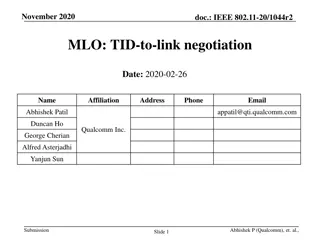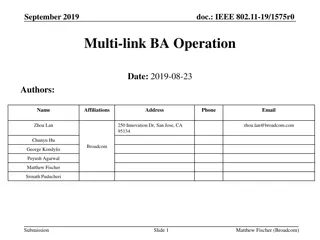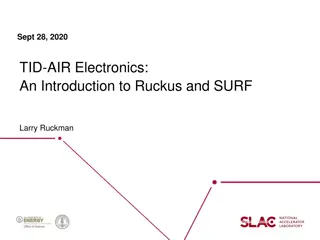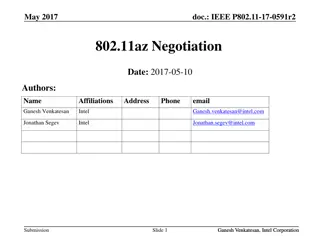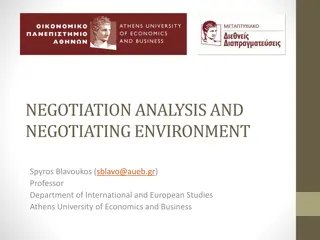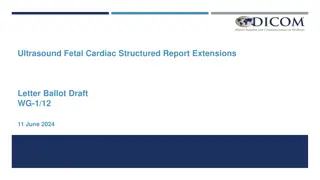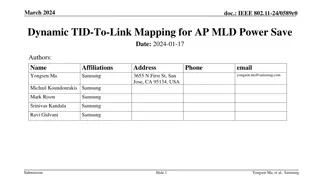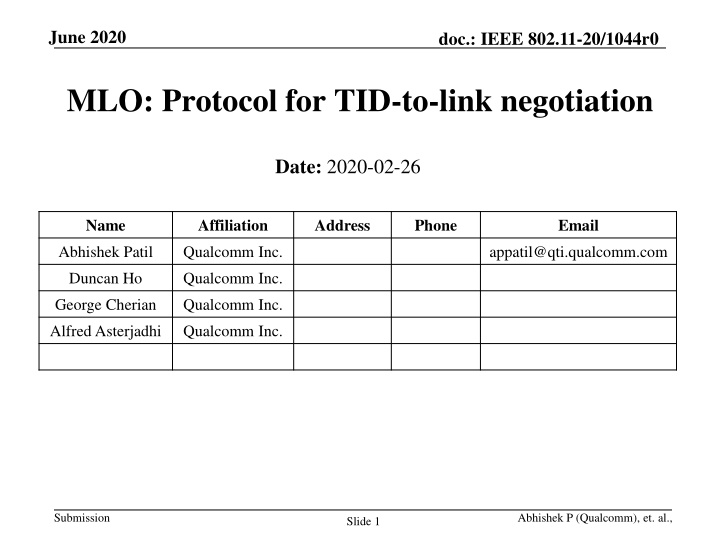
Protocol for TID-to-Link Negotiation in MLO
"Learn about the protocol for negotiating TID-to-link mappings in MLO, addressing issues such as proposed link changes and negotiation outcomes based on response scenarios. Understand the rules for successful mapping negotiation and how to handle failed negotiations effectively."
Download Presentation

Please find below an Image/Link to download the presentation.
The content on the website is provided AS IS for your information and personal use only. It may not be sold, licensed, or shared on other websites without obtaining consent from the author. If you encounter any issues during the download, it is possible that the publisher has removed the file from their server.
You are allowed to download the files provided on this website for personal or commercial use, subject to the condition that they are used lawfully. All files are the property of their respective owners.
The content on the website is provided AS IS for your information and personal use only. It may not be sold, licensed, or shared on other websites without obtaining consent from the author.
E N D
Presentation Transcript
June 2020 doc.: IEEE 802.11-20/1044r0 MLO: Protocol for TID-to-link negotiation Date: 2020-02-26 Name Affiliation Address Phone Email Abhishek Patil Qualcomm Inc. appatil@qti.qualcomm.com Duncan Ho Qualcomm Inc. George Cherian Qualcomm Inc. Alfred Asterjadhi Qualcomm Inc. Submission Abhishek P (Qualcomm), et. al., Slide 1
June 2020 doc.: IEEE 802.11-20/1044r0 Background MLDa TIDbe TIDvo TID-to-link feature maps a TID to one or more links The frames belonging to the TID are sent on the mapped link(s) Such traffic separate can aid latency sensitive traffic flow Assign a high-volume, latency tolerant traffic flow to a subset of link while mapping latency sensitive flows to all links Increases channel access opportunities for a latency sensitive flow At a system level, reduces contention between latency sensitive and latency tolerant flows STAa 1 STAa 3 STAa 2 Link 1 Link 3 Link 2 STAb 3 STAb 2 STAb 1 Other use cases include load balancing, co- ex conditions, separating UL/DL flows etc MLDb Submission Slide 2 Abhishek P (Qualcomm), et. al.,
June 2020 doc.: IEEE 802.11-20/1044r0 Problem Statement In MLO, MLDs negotiate TID to link mapping. Either MLD can initiate a change to the default or existing mapping Non-AP MLD AP MLD TID-4 maps to 5 GHz However, the receiving MLD may not agree to the proposed mapping What is the outcome of the negotiation? ? MLO framework needs to provide a protocol for determining the result of a TID-to-link negotiation Time Submission Slide 3 Abhishek P (Qualcomm), et. al.,
June 2020 doc.: IEEE 802.11-20/1044r0 Result of TID to link negotiation We propose simple rules to decide the outcome of TID mapping negotiation. We follow existing baseline rules for any negotiation for example, BA setup ADDBA Req [BA size of 128] + ADDBA Resp [BA size of 128] = [BA negotiated for 128] ADDBA Req [BA size of 256] + ADDBA Resp [BA size of 64] = [BA negotiated for 64] If the responding MLD replies with the same set of links as the ones proposed by the initiating MLD, the resulting mapping is the link set proposed by the initiator Negotiation is considered success Else, if the responding MLD proposes an alternative set of links that consists of a subset of requested links, the resulting mapping consists of the subset of links Negotiation is considered success When the responding MLD replies with an empty set, the original mapping is maintained Negotiation is considered failed The initiating MLD could make another attempt at a later point Submission Slide 4 Abhishek P (Qualcomm), et. al.,
June 2020 doc.: IEEE 802.11-20/1044r0 TID mapping negotiation By default, all TIDs are mapped to all links Either MLD can initiate a change to the existing mapping During the negotiations An initiating MLD can: request expanding the link set for a TID request contracting the link set for a TID request switching the link set for a TID A responding MLD provides the links (from the proposed set) that it can operate on When the proposed link set includes link(s) that are already part of the existing mapping, the responding MLD includes at least one link from that set. If the responder was not happy with the current set, it would have initiated a change to the mapping Submission Slide 5 Abhishek P (Qualcomm), et. al.,
June 2020 doc.: IEEE 802.11-20/1044r0 Rational for converging on a subset An MLD (initiator or responder) that has constraints may propose a smaller set of links For example, a non-AP MLD may have co-ex or power-save constraints due to which it can t operate on a certain link (or accept a request to expand to multiple links) An AP MLD may want to keep high volume (latency tolerant) flows out of certain links to reduce contention with latency sensitive flows Latency sensitive flows are expected to be mapped on to multiple links to benefit from multiple access opportunities. Further a responding MLD may reject a proposed switching of links if it is unable to operate on the suggested link set Therefore, by selecting a subset, the convergence protocol can satisfy both parties. Once the constraints no longer apply, an MLD can always initiate an expansion of the link set for that TID Submission Slide 6 Abhishek P (Qualcomm), et. al.,
June 2020 doc.: IEEE 802.11-20/1044r0 TID Negotiation Before: TID-4 maps to 5 GHz Before: TID-4 maps to 2.4 & 5 GHz Before: TID-4 maps to 5 GHz MLD 2 MLD 1 MLD 1 MLD 2 MLD 2 MLD 1 Time Time Time After: TID-4 maps to 5 GHz After: TID-4 maps to 2.4 & 5 GHz After: TID-4 maps to 5 GHz Responding MLD agrees with the proposed set of links. TID mapping for TID 4 expanded to include 2.4. Expansion attempt unsuccessful. Responding MLD unable to add to 2.4 to the link set for TID 4 Link set for TID-4 reduced to 5 GHz as proposed by the initiating MLD Link Expansion Original TID mapping is maintained Link set contraction Submission Slide 7 Abhishek P (Qualcomm), et. al.,
June 2020 doc.: IEEE 802.11-20/1044r0 TID Negotiation Before: TID-4 maps to 5 GHz Before: TID-4 maps to 5 GHz Before: TID-4 maps to 5 GHz MLD 1 MLD 2 MLD 1 MLD 1 MLD 2 MLD 2 Time Time Time After: TID-4 maps to 6 GHZ After: TID-4 maps to 5 GHz After: TID-4 maps to 6 GHz Switching attempt unsuccessful. Responding MLD unable to switch to 6 GHz Responding MLD agrees with the proposed switching. TID mapping for TID 4 switched to 6 GHz. TID switches to subset of proposed link(s). Responding MLD unable to switch to 2.4 Original TID mapping is maintained Link switched to 6 GHz Link set switched to subset of proposed Submission Slide 8 Abhishek P (Qualcomm), et. al.,
June 2020 doc.: IEEE 802.11-20/1044r0 Conflicting constraints Factors Non-AP MLD AP MLD Power-save Yes prefer to have min RF s ON No Low latency Yes more links increase access opportunities Yes more links increase access opportunities System performance No has local view and selfish motives Yes has global view and goal to serve all STAs Others (coex etc) Co-ex: Yes Traffic separation: not so much Co-ex: Yes for soft AP Traffic separation: Yes The table shows the conflicting requirements that need to be satisfied: low-lat and power-save are opposing requirements Similarly AP/client have opposing view of system performance avoid overlap of latency tolerant flow from one client and a latency sensitive flow from another client Submission Slide 9 Abhishek P (Qualcomm), et. al.,
June 2020 doc.: IEEE 802.11-20/1044r0 Satisfying conflicting requirements A non-AP MLD (client device) prefers to: have minimal links enabled for power-save reasons (i.e., prefer not to have disjoint mapping) use all links for low latency flows use any link for UL An AP MLD serves the needs of many and therefore: can receive UL on any link strives to reduce the contention between best effort and latency sensitive flows These conflicting interests can be met by a couple of simple rules: Rule #1: A low-lat TID is mapped on to multiple links (multi-primary benefit) Rule #2: For a non-AP MLD, AP MLD provides at least one link where all TIDs are mapped (aids power-save) To reduce contention between best effort and latency sensitive flows: AP can attempt to have the set of link(s) where all TIDs are mapping to be common for all non-AP MLDs (link can be on a lower band channel to satisfy range/reachability) Goal is to reduce the contention between latency sensitive and latency tolerant flows across all clients Submission Slide 10 Abhishek P (Qualcomm), et. al.,
June 2020 doc.: IEEE 802.11-20/1044r0 Summary This contribution provides simple rules for determining the result of a TID-to-link negotiation The negotiation is considered a success when there is at least one link common in the set proposed by the initiating and responding MLD The resulting mapping is the subset (consisting of common) links In case of no overlap, the negotiation is deemed as failed and there is no change to the TID mapping The contribution further provides rules for addressing the conflicting requirements from each side. An AP MLD must provide at least one link where all TIDs map to Map latency tolerant TIDs to a subset of links while latency sensitive flows are mapped to all or most of the setup links Submission Slide 11 Abhishek P (Qualcomm), et. al.,
June 2020 doc.: IEEE 802.11-20/1044r0 SP #1 Do you agree that an AP MLD shall ensure that for each non-AP MLD with which it has performed ML setup, there is at least one link to which all TIDs map to? Y: N: A: Submission Slide 12 Abhishek P (Qualcomm), et. al.,
June 2020 doc.: IEEE 802.11-20/1044r0 SP #2 Do you agree that the TID-to-link mapping negotiation shall result in a TID being mapped to a set of links that are common between the links proposed by the initiating MLD and the ones proposed by the responding MLD? When the proposed link set includes link(s) that are already part of the current mapping, the responding MLD shall include at least one link from that set. NOTE: a responding MLD is expected to be OK to operate on the link set where the TID is currently mapped on to When there are no common links between the ones proposed by the initiator and responder, the negotiation is deemed as failed and there is no change to the TID mapping Y: N: A: Submission Slide 13 Abhishek P (Qualcomm), et. al.,
June 2020 doc.: IEEE 802.11-20/1044r0 SP #3 Do you agree that an AP MLD should have the same set of link(s) to which all TIDs map for all the non-AP MLDs with which it has performed ML setup? Y: N: A: Submission Slide 14 Abhishek P (Qualcomm), et. al.,
June 2020 doc.: IEEE 802.11-20/1044r0 SP #4 Do you agree that, when there is an active latency sensitive flow, an AP MLD should negotiate to map a latency tolerant flow belonging to a non-AP MLD to a subset of links and negotiate mapping of the latency sensitive flow to all links? Y: N: A: Submission Slide 15 Abhishek P (Qualcomm), et. al.,



